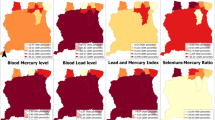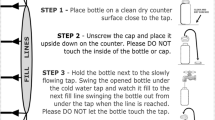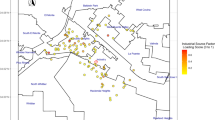Abstract
High blood lead (BPb) levels in children and elevated soil and dust arsenic, cadmium, and lead were previously found in Torreón, northern Mexico, host to the world’s fourth largest lead–zinc metal smelter. The objectives of this study were to determine spatial distributions of adolescents with higher BPb and creatinine-corrected urine total arsenic, cadmium, molybdenum, thallium, and uranium around the smelter. Cross-sectional study of 512 male and female subjects 12–15 years of age was conducted. We measured BPb by graphite furnace atomic absorption spectrometry and urine trace elements by inductively coupled plasma-mass spectrometry, with dynamic reaction cell mode for arsenic. We constructed multiple regression models including sociodemographic variables and adjusted for subject residence spatial correlation with spatial lag or error terms. We applied local indicators of spatial association statistics to model residuals to identify hot spots of significant spatial clusters of subjects with higher trace elements. We found spatial clusters of subjects with elevated BPb (range 3.6–14.7 μg/dl) and urine cadmium (0.18–1.14 μg/g creatinine) adjacent to and downwind of the smelter and elevated urine thallium (0.28–0.93 μg/g creatinine) and uranium (0.07–0.13 μg/g creatinine) near ore transport routes, former waste, and industrial discharge sites. The conclusion derived from this study was that spatial clustering of adolescents with high BPb and urine cadmium adjacent to and downwind of the smelter and residual waste pile, areas identified over a decade ago with high lead and cadmium in soil and dust, suggests that past and/or present plant operations continue to present health risks to children in those neighborhoods.
This is a preview of subscription content, access via your institution
Access options
Subscribe to this journal
Receive 6 print issues and online access
$259.00 per year
only $43.17 per issue
Buy this article
- Purchase on Springer Link
- Instant access to full article PDF
Prices may be subject to local taxes which are calculated during checkout





Similar content being viewed by others
References
Calderon-Salinas JV, Valdez-Anaya B, Mazuniga C, Albores-Medina A . Lead exposure in a population of Mexican children. Hum Exp Toxicol 1996; 15: 305–311.
Garcia Vargas GG, Rubio Andrade M, Del Razo LM, Borja Aburto V, Vera Aguilar E, Cebrian ME . Lead exposure in children living in a smelter community in region Lagunera, Mexico. J Toxicol Environ Health A 2001; 62: 417–429.
Albalak R, McElroy RH, Noonan G, Buchanan S, Jones RL, Flanders WD et al. Blood lead levels and risk factors for lead poisoning among children in a Mexican smelting community. Arch Environ Health 2003; 58: 172–183.
Benin AL, Sargent JD, Dalton M, Roda S . High concentrations of heavy metals in neighborhoods near ore smelters in northern Mexico. Environ Health Perspect 1999; 107: 279–284.
Rosado JL, Ronquillo D, Kordas K, Rojas O, Alatorre J, Lopez P et al. Arsenic exposure and cognitive performance in Mexican schoolchildren. Environ Health Perspect 2007; 115: 1371–1375.
Recio-Vega R, Valdez-Abrego C, Gurrola-Mendez A . Surveillance of elevated blood lead levels in children in Torreon, Coahuila, Mexico, 1998–2010. Int J Hygiene Environ Health 2011; 215: 507–513.
EPA (United States Environmental Protection Agency) International Smelting and Refining Superfund Site, [Internet]. 2007 [updated 12 January 2013]. EPA CERCLIS No. UTD093120921, Tooele, Utah; Part I, Declaration of the Record of Decision. Available from www.epa.gov/region8/superfund/ut/intrntnlsmelt/ROD.pdf.
EPA (United States Environmental Protection Agency) [Internet]. 2012 [updated: 12 January 2013]. Answers to Frequent Questions about the Colorado Smelter Site. Available from www.epa.gov/region8/superfund/co/colosmelter/ColoSmelterFAQs082312_1.pdf.
IEM (Iowa International Mesonet) Custom Wind Roses [Internet]. 2011 (accessed: 20 July 2012] Available from http://mesonet.agron.iastate.edu/sites/dyn_windrose.phtml?station=MMTC&network=MX_ASOS&units=mph&nsector=36&year1=2011&month1=1&day1=1&hour1=12&minute1=0&year2=2011&month2=12&day2=1&hour2=12&minute2=0.
Miller DT, Paschal DC, Gunter EW, Stroud PE, D'Angelo J . Determination of lead in blood using electrothermal atomisation atomic absorption spectrometry with a L'vov platform and matrix modifier. Analyst 1987; 112: 1701–1704.
Minnich MG, Miller DC, Parsons PJ . Determination of As, Cd, Pb, and Hg in urine using inductively coupled plasma mass spectrometry with the direct injection high efficiency nebulizer. Spectroc Acta Pt B Atom Spectr 2008; 63: 389–395.
Aguilar-Muñiz AU Efectos estacionales en los niveles de arsénico de pozos urbanos de la Comarca Lagunera. [MSc Thesis]. Instituto Tecnológico de la Laguna. Torreón, Coahuila, México 2012.
Elmer Perkin Analysis of natural waters: Determination of metals using an extraction procedure, Analytical Methods for Atomic Absorption Spectrometry. Edited by Perkin Elmer Instruments. 2000,, 190–191.
Rosas I, Belmont R, Armienta A, Baez A . Arsenic concentrations in water, soil, milk and forage in Comarca Lagunera, Mexico. Water Air Soil Poll 1999; 112: 133–149.
Navas-Acien A, Francesconi KA, Silbergeld EK, Guallar E . Seafood intake and urine concentrations of total arsenic, dimethylarsinate andarsenobetaine in the US population. Environ Res 2011; 111: 110–118.
Anselin L, Ibnu S, Youngihn K . GeoDa: an introduction to spatial data analysis. Geogr Anal 2006; 38: 5–22.
INEGI (Instituto Nacional de Estadística, Geografía e Informática) [Internet]. 2012. [updated: 15 July 2012] [Available from http://gaia.inegi.org.mx/mdm5/].
Anselin L, Rey S . Properties of tests for spatial dependence in Linear Regression Models. Geogr Anal 1991; 23: 112–131.
Anselin L . Local indicators of spatial association-LISA. Geogr Anal 1995; 27: 93–115.
Sibson RA . Brief Description of Natural Neighbor Interpolation. In: Barnett V, (ed). Interpreting Multivariate Data 1981. John Wiley and Sons: New York, USA, 21–36.
US Department of Defense Global Positioning System Standard Positioning Service Performance Standard 4th Ed. GPS NAVSTAR. Washington, DC. [Internet]. September 2008. [updated 30 June 2013]. [Available from http://www.gps.gov/technical/ps/2008-SPS-performance-standard.pdf].
Garcia Vargas GG, Andrade MR, Rosales Gonzalez MG, Goytia Acevedo R, Garcia Arenas G, Candelas Rangel JL et al. Contaminación por metales en suelos de la ciudad de Torreón, Coahuila, Mexico. Revistaa Chapingo Serie Zonas Aridas 2007; 6: 165–168.
CDC (Centers for Disease Control and Prevention) [Internet]. 2012. CDC Response to Advisory Committee on Childhood Lead Poisoning Prevention Recommendations in “Low Level Lead Exposure Harms Children: A Renewed Call of Primary Prevention” [Updated 12 January 2013][Available from http://www.cdc.gov/nceh/lead/acclpp/cdc_response_lead_exposure_recs.pdf].
Noonan G, Albalak R, Kim D, Buchanan S, McElroy RH, Schurz-Rogers H et alBlood lead levels and risk factors for lead poisoning among children in Torreon, Coahuila, Mexico Final Report. [Internet]. US Centers for Disease Control and Prevention; no publication date. [updated 30 November 2012]. [Available from http://www.bvsde.paho.org/bvsea/fulltext/torreon.pdf].
SEMARNAT (Secretaría de Medio Ambiente y Recursos Naturales) Programa para Mejorar la Calidad del Aire en la Región de la Comarca Lagunera 2010–2015. [Internet]. no publication date. [updated 3 December 2012]. [Available from www.semarnat.gob.mx/temas/gestionambiental/ProAires_Vigentes/9_ProAire Comarca Lagunera 2010_2015.pdf].
SEMARNAT Límites normados para los contaminantes de aire en México [Internet]. No publication date. [updated 29 January 2013]. [Available from http://www.ine.gob.mx/calaire-informacion-basica/585-calaire-val-normados].
EPA Lead Air Quality Standards. [Internet]. 2008. [Updated: 14 January 2013] (Available from www.epa.gov/air/lead/standards.html).
Acknowledgements
We thank the Coahuila State Ministry of Health for providing the facilities for the study. This study was supported by grant no. R01 ES015597, National Institute of Environmental Health Sciences, U.S. Public Health Service.
Author information
Authors and Affiliations
Corresponding author
Ethics declarations
Competing interests
The authors declare no conflict of interest.
Additional information
Supplementary Information accompanies the paper on the Journal of Exposure Science and Environmental Epidemiology website
Supplementary information
Rights and permissions
About this article
Cite this article
Garcia-Vargas, G., Rothenberg, S., Silbergeld, E. et al. Spatial clustering of toxic trace elements in adolescents around the Torreón, Mexico lead–zinc smelter. J Expo Sci Environ Epidemiol 24, 634–642 (2014). https://doi.org/10.1038/jes.2014.11
Received:
Accepted:
Published:
Issue Date:
DOI: https://doi.org/10.1038/jes.2014.11
Keywords
This article is cited by
-
Validity of Geolocation and Distance to Exposure Sources from Geographical Information Systems for Environmental Monitoring of Toxic Metal Exposures Based on Correlation with Biological Samples: a Systematic Review
Current Environmental Health Reports (2022)
-
Early-life Pb exposure as a potential risk factor for Alzheimer’s disease: are there hazards for the Mexican population?
JBIC Journal of Biological Inorganic Chemistry (2019)
-
Biomonitoring for uranium exposure among young children living in nineteen states across five regions of Brazil
Journal of Radioanalytical and Nuclear Chemistry (2018)
-
Use of two indicators for the socio-environmental risk analysis of Northern Mexico under three climate change scenarios
Air Quality, Atmosphere & Health (2015)



